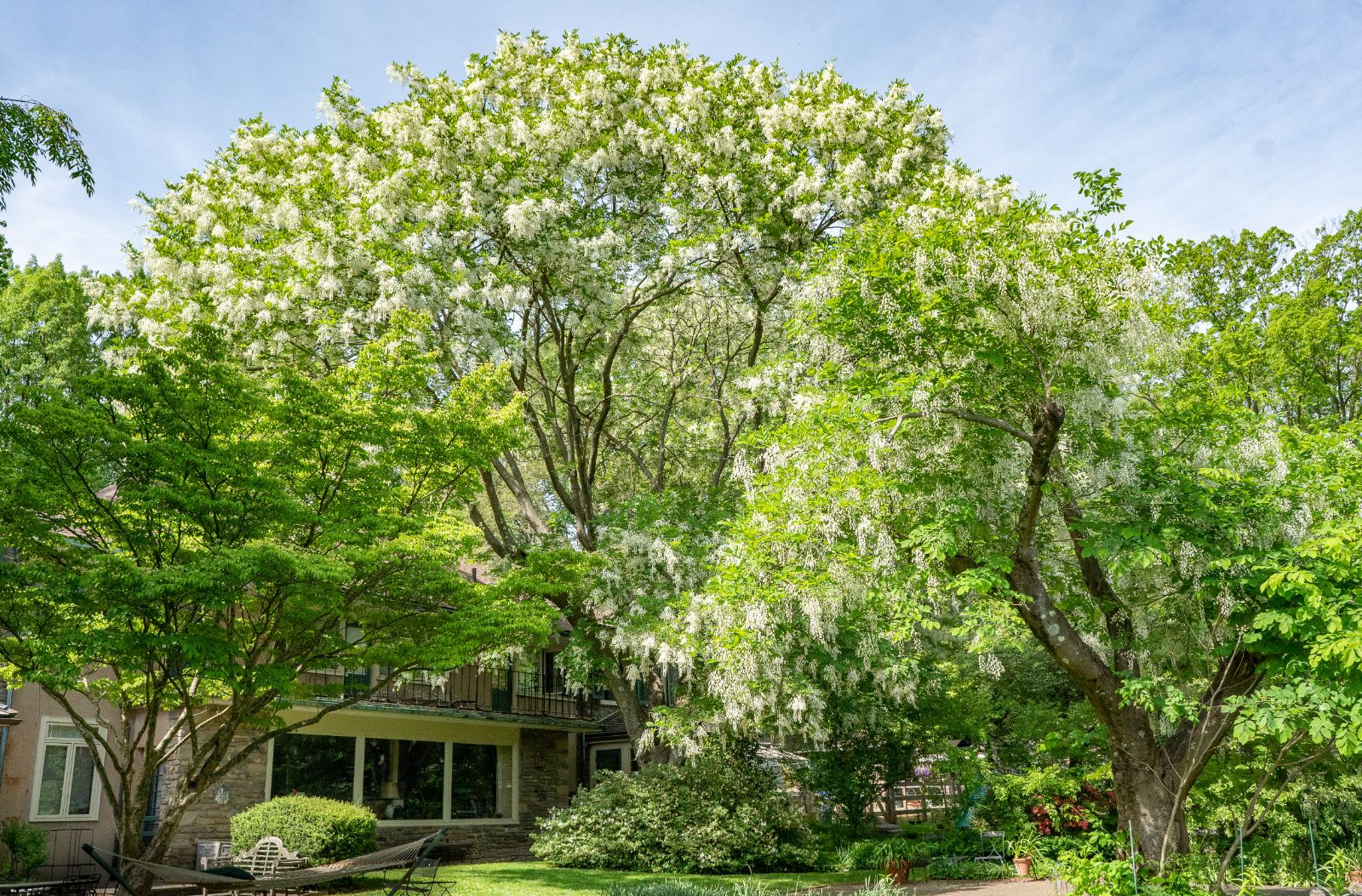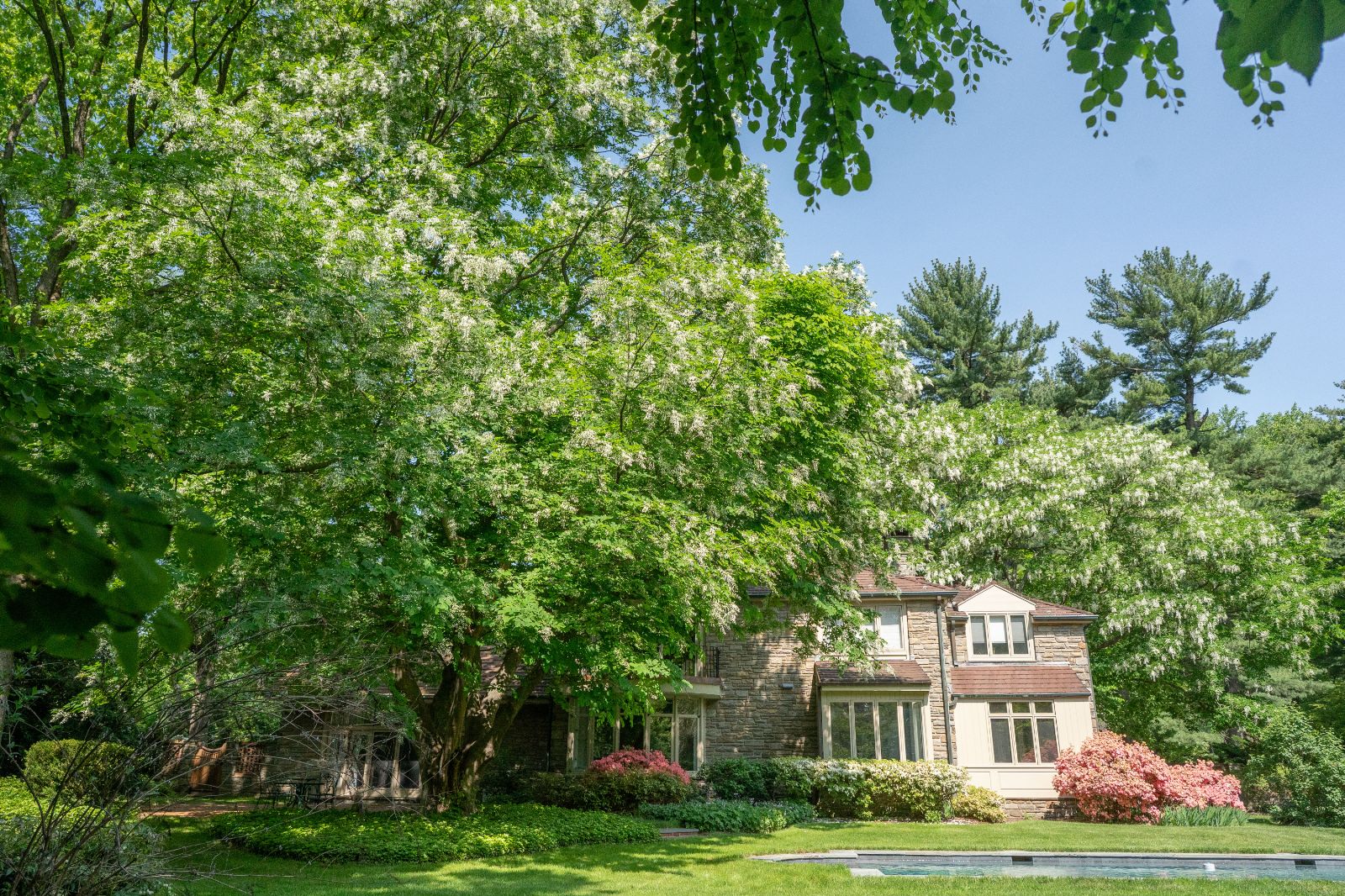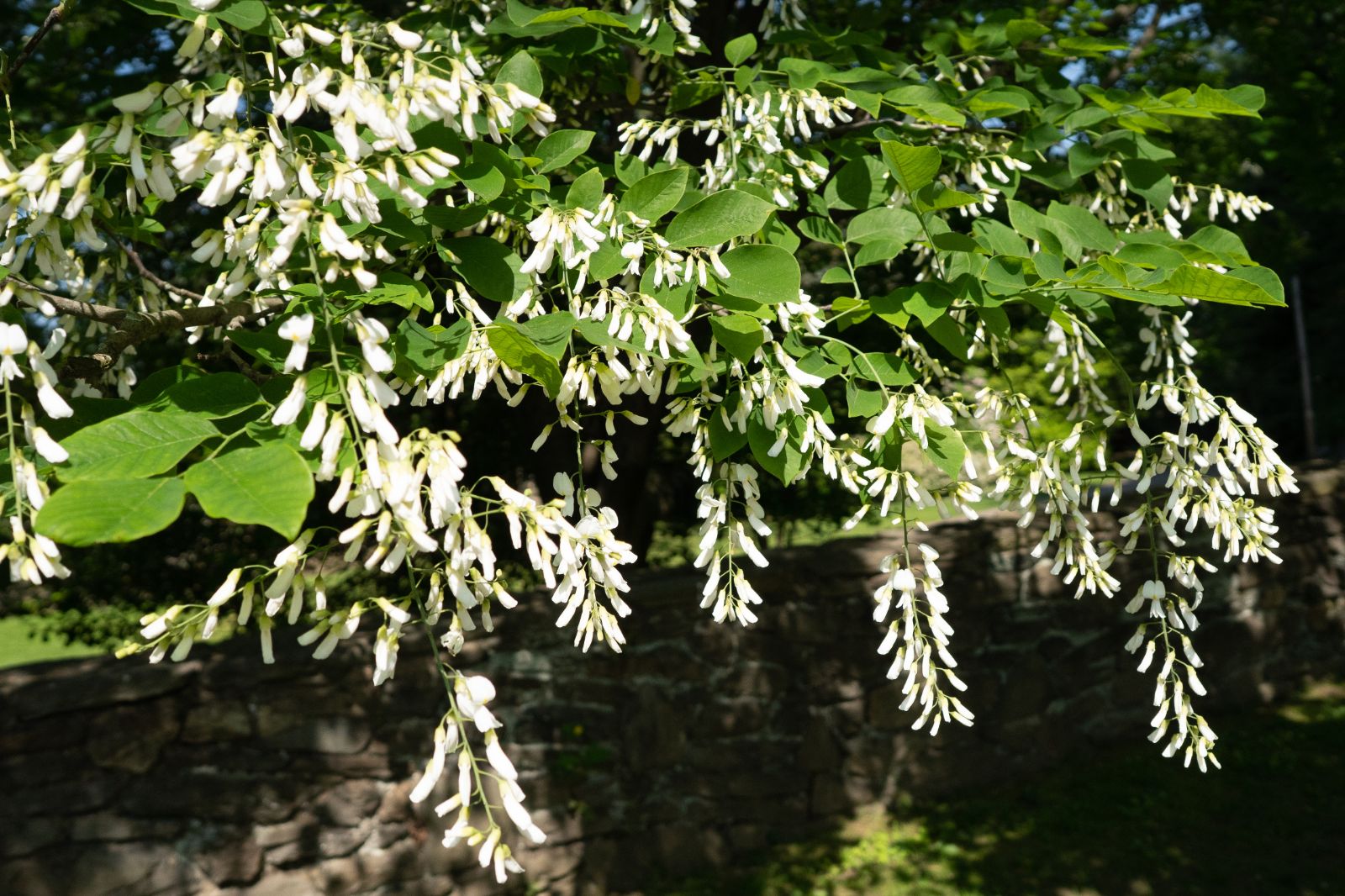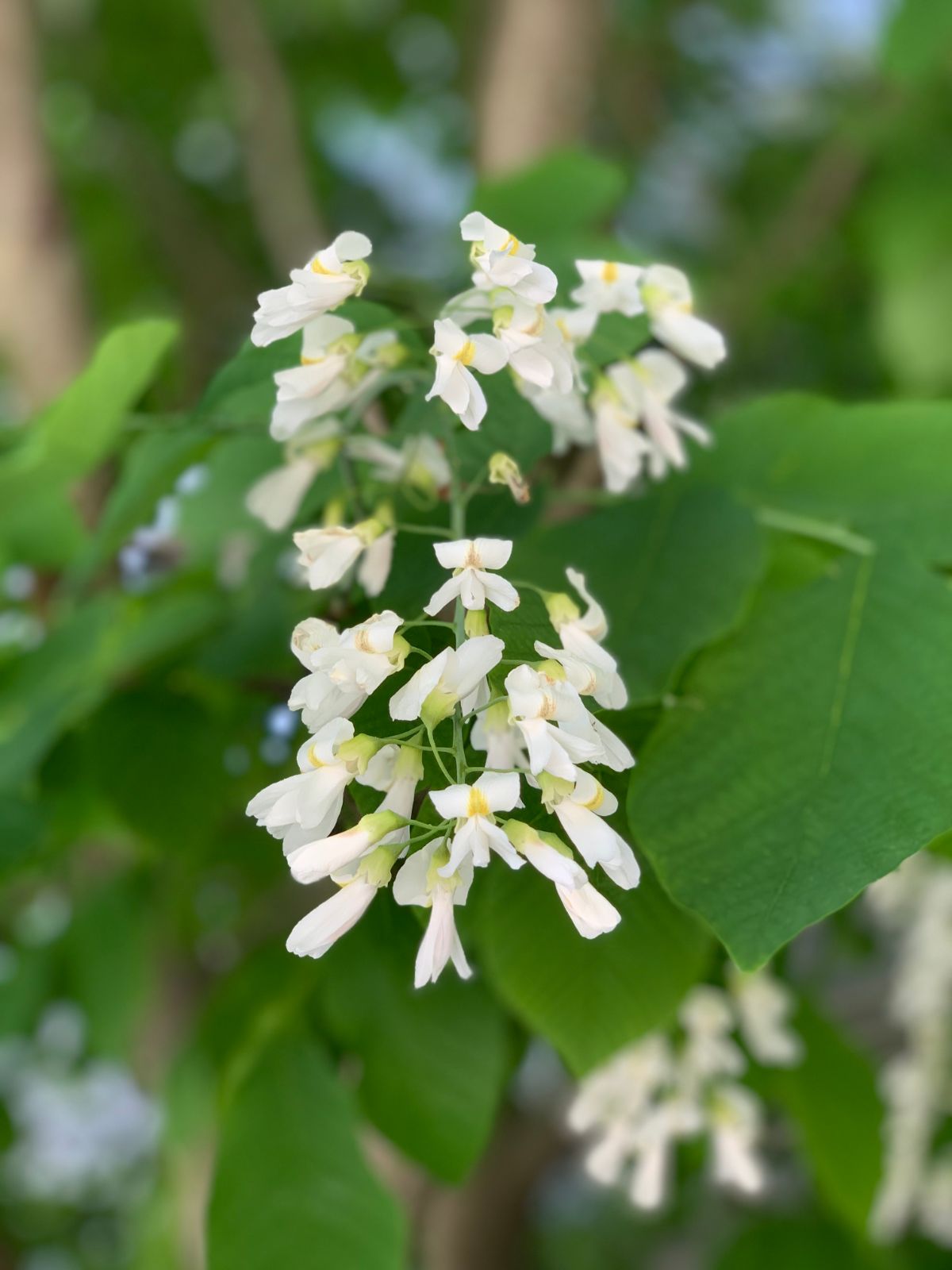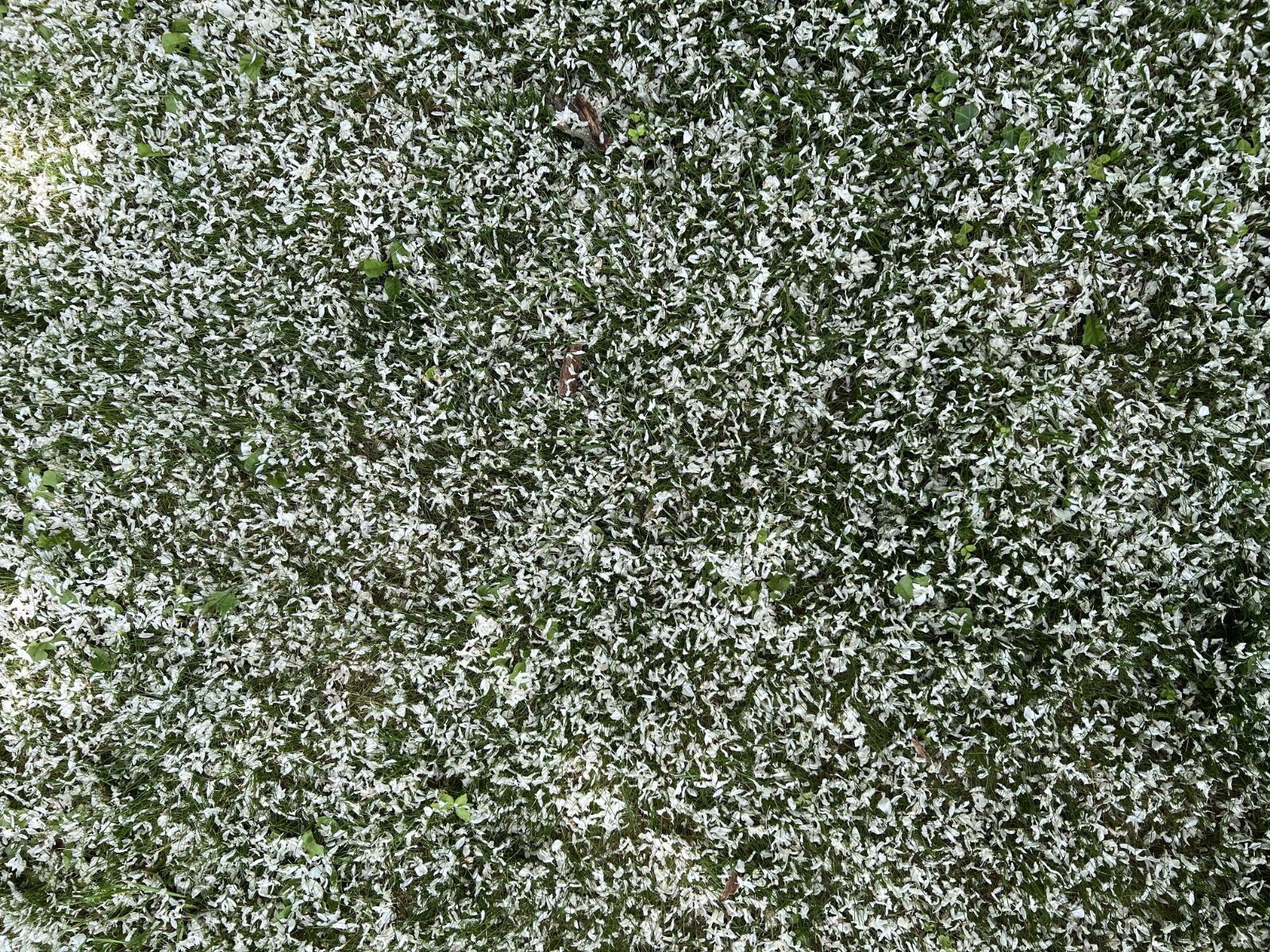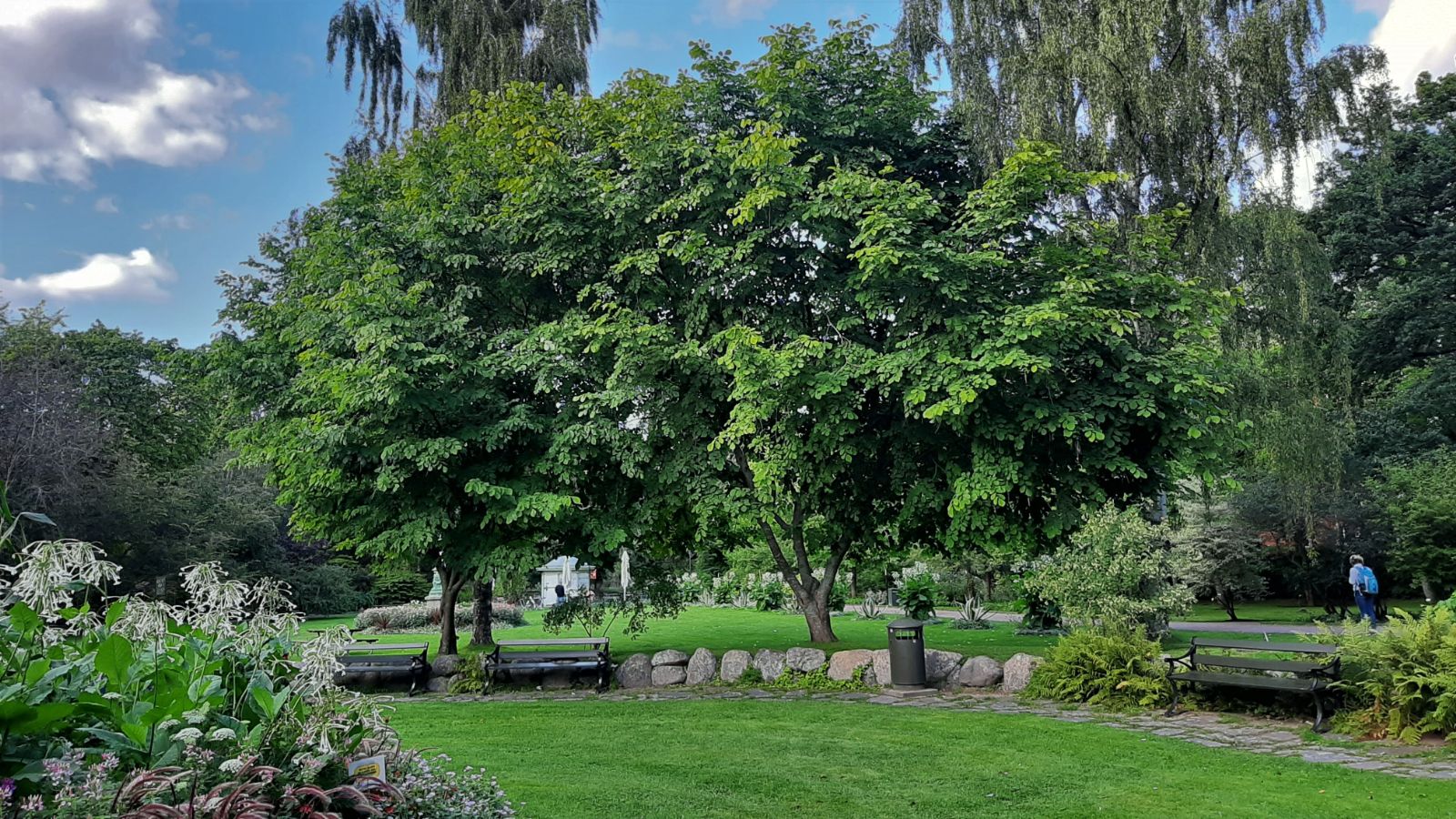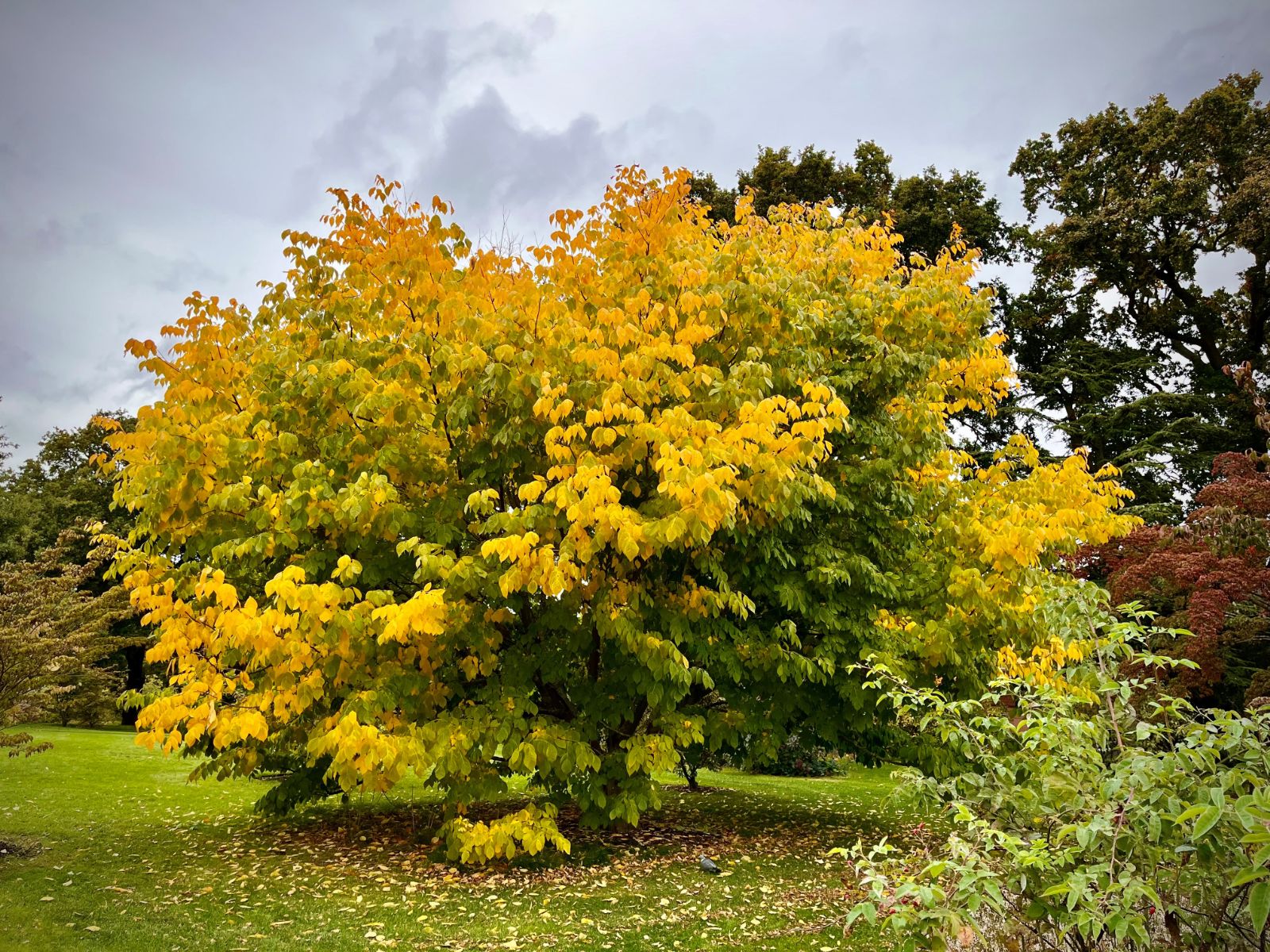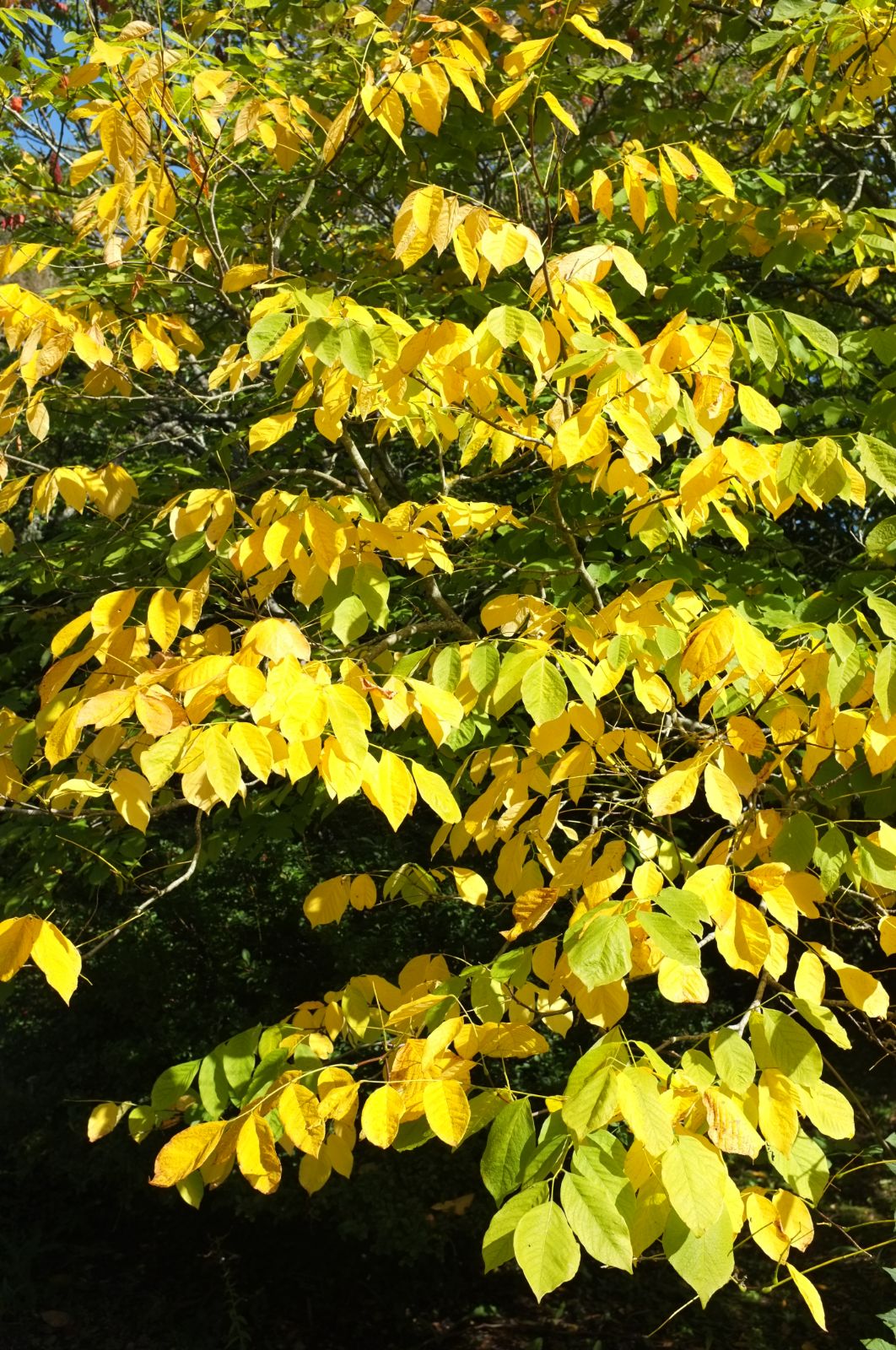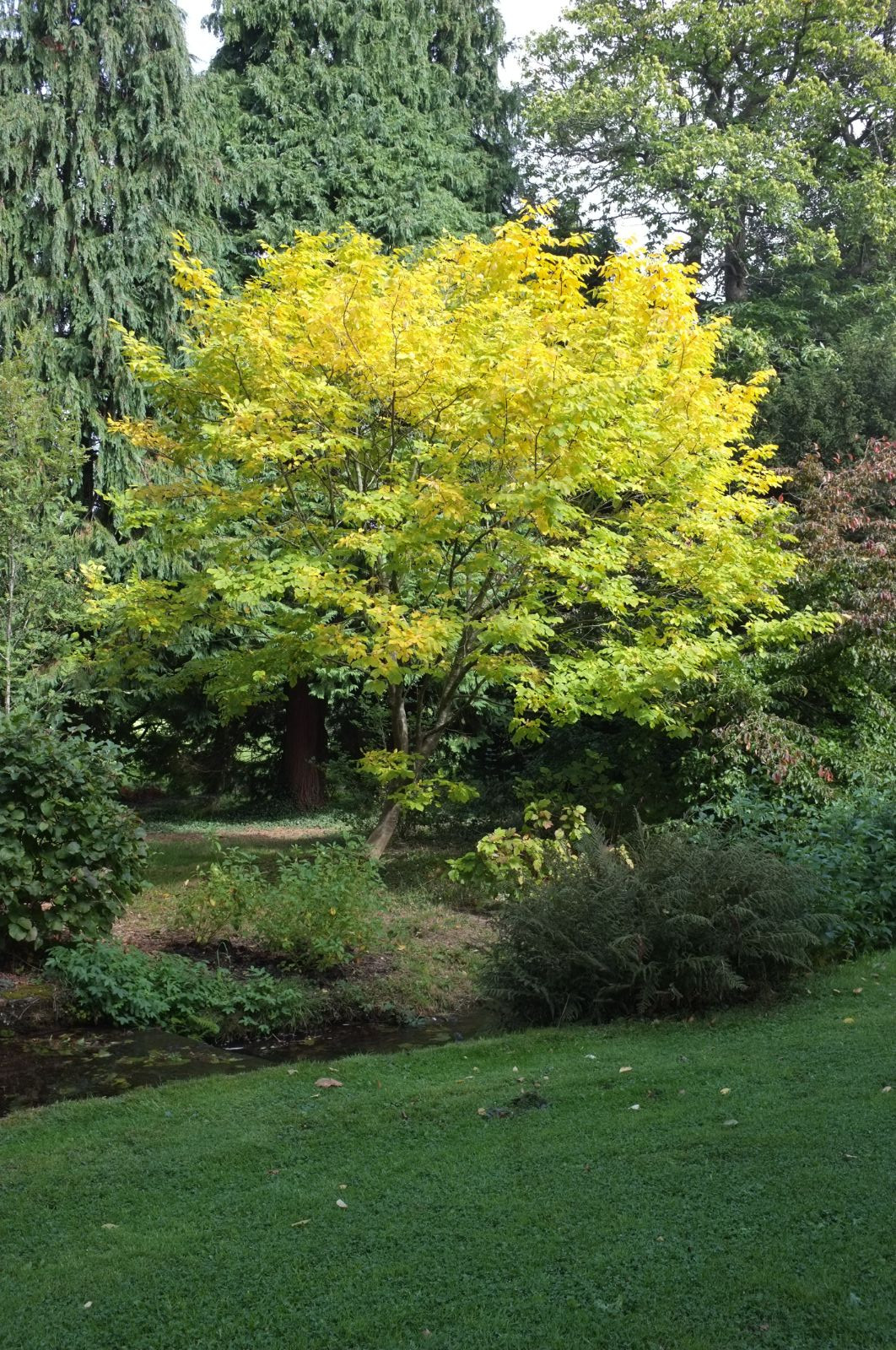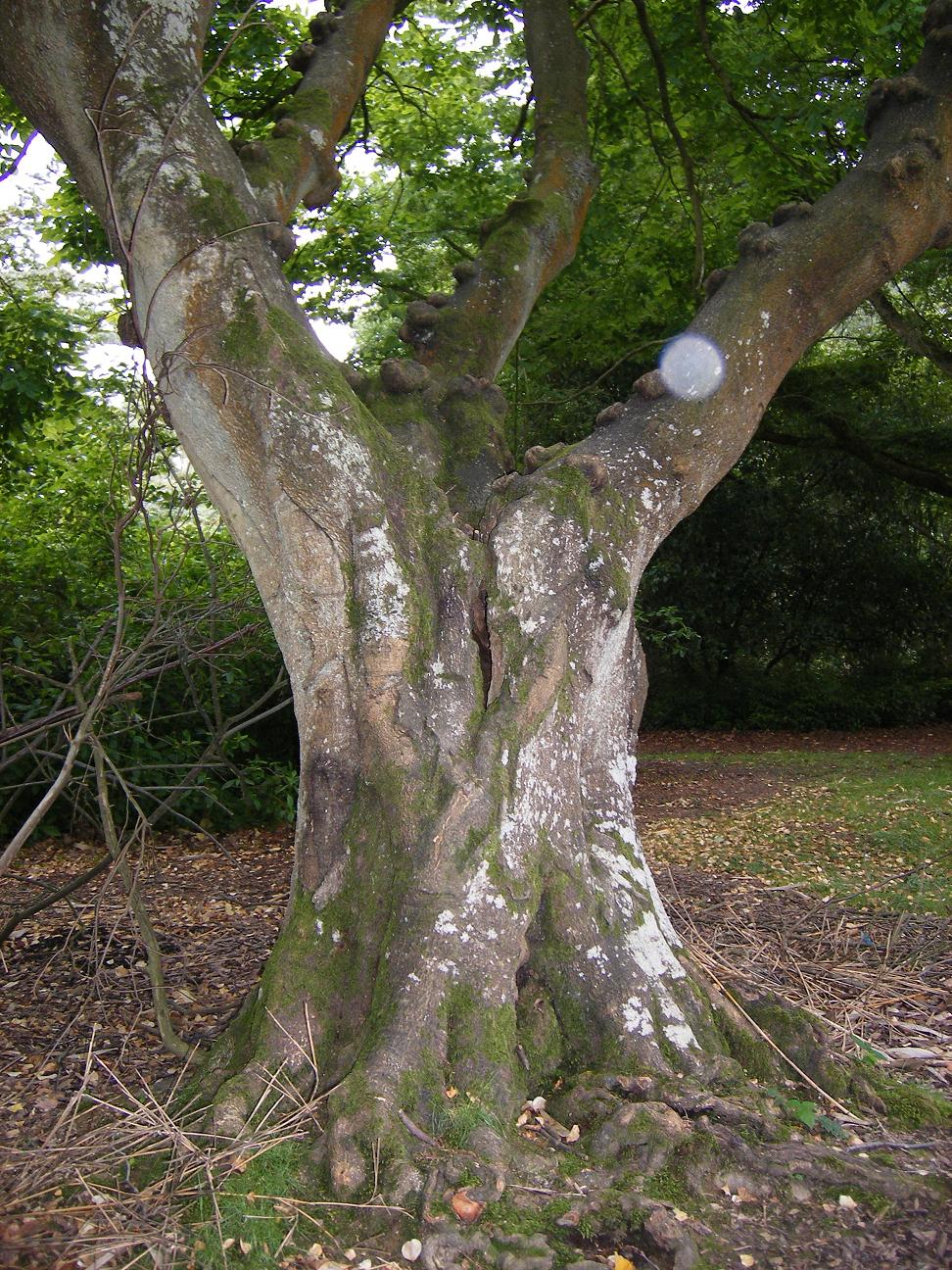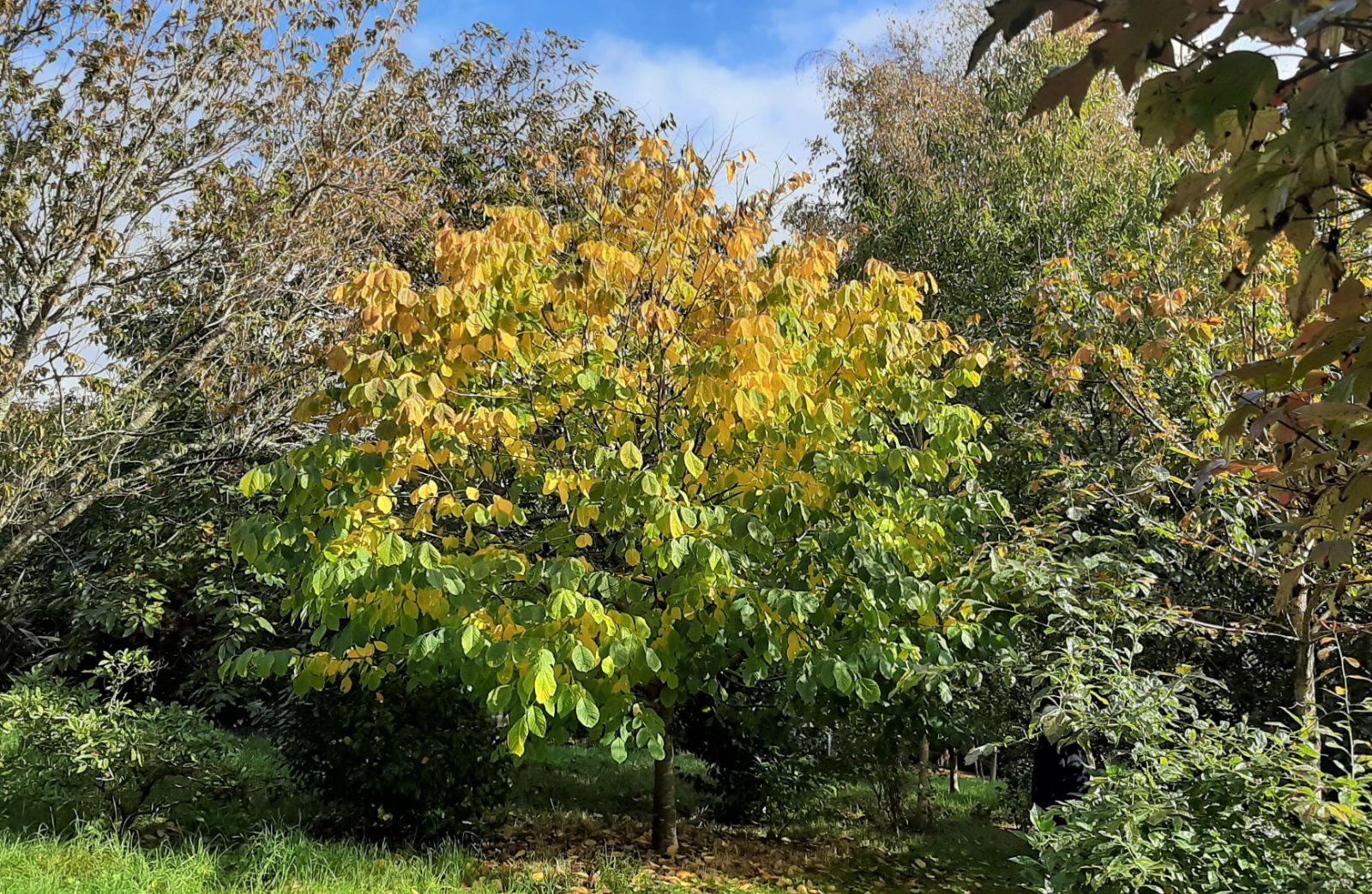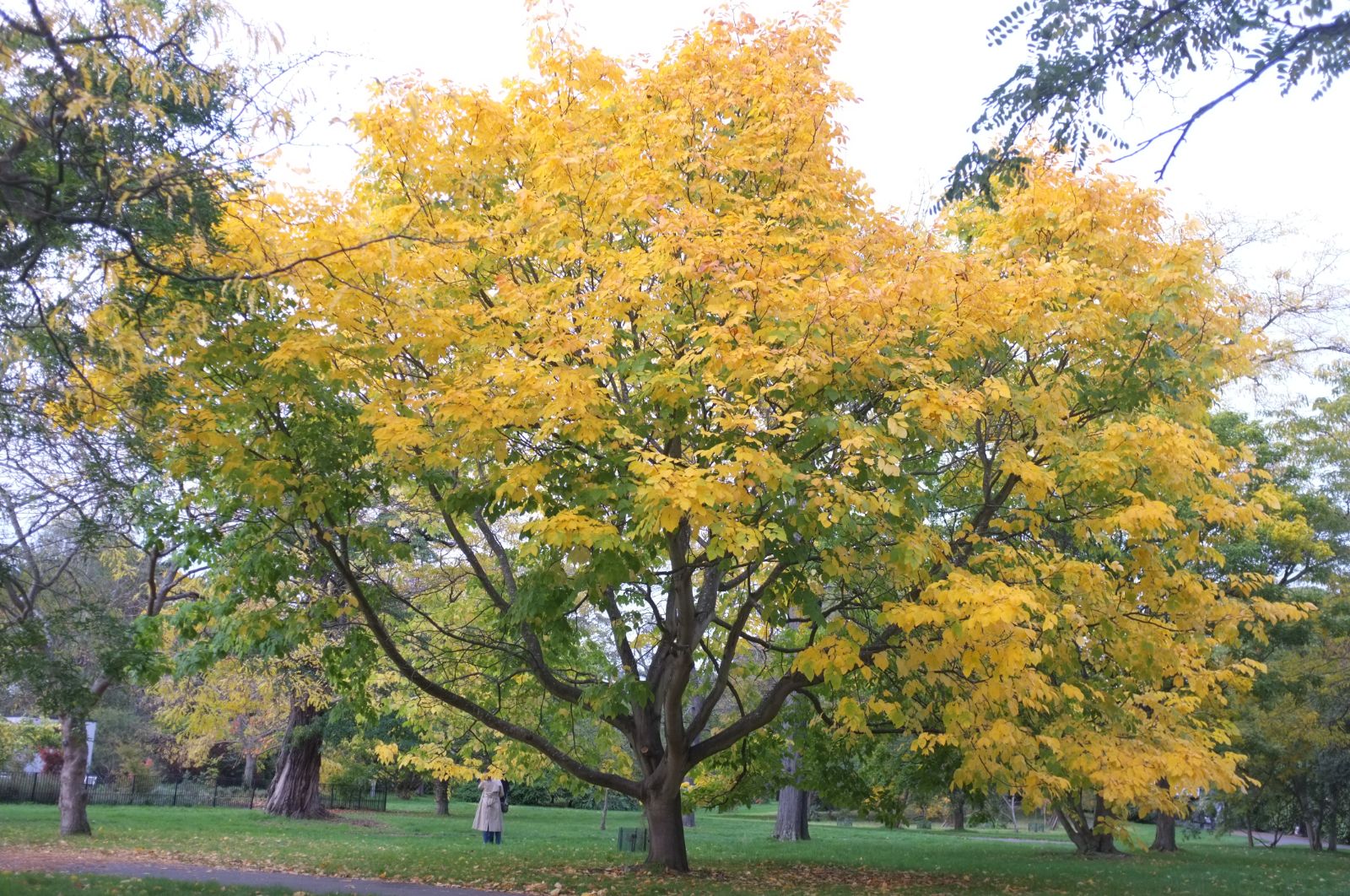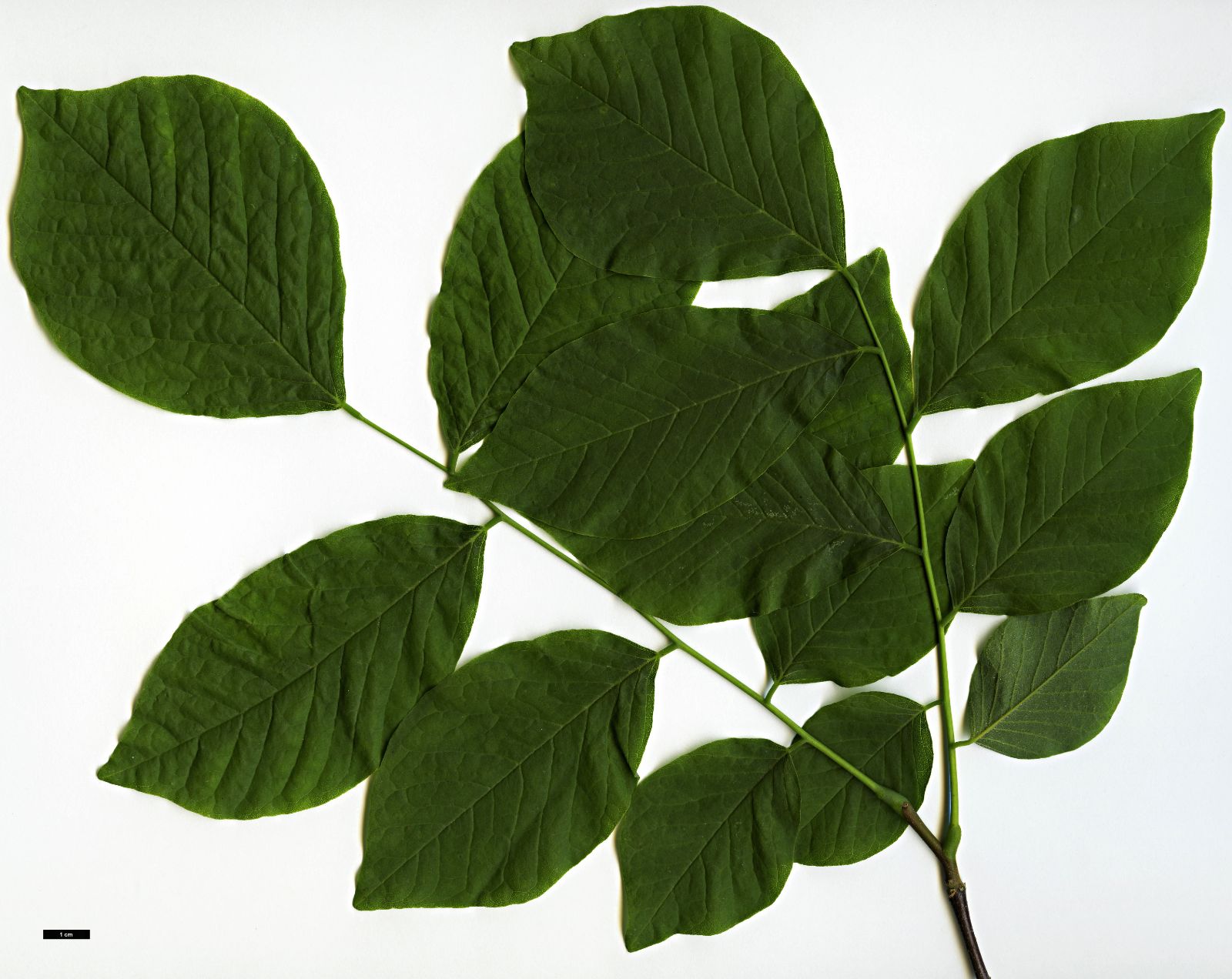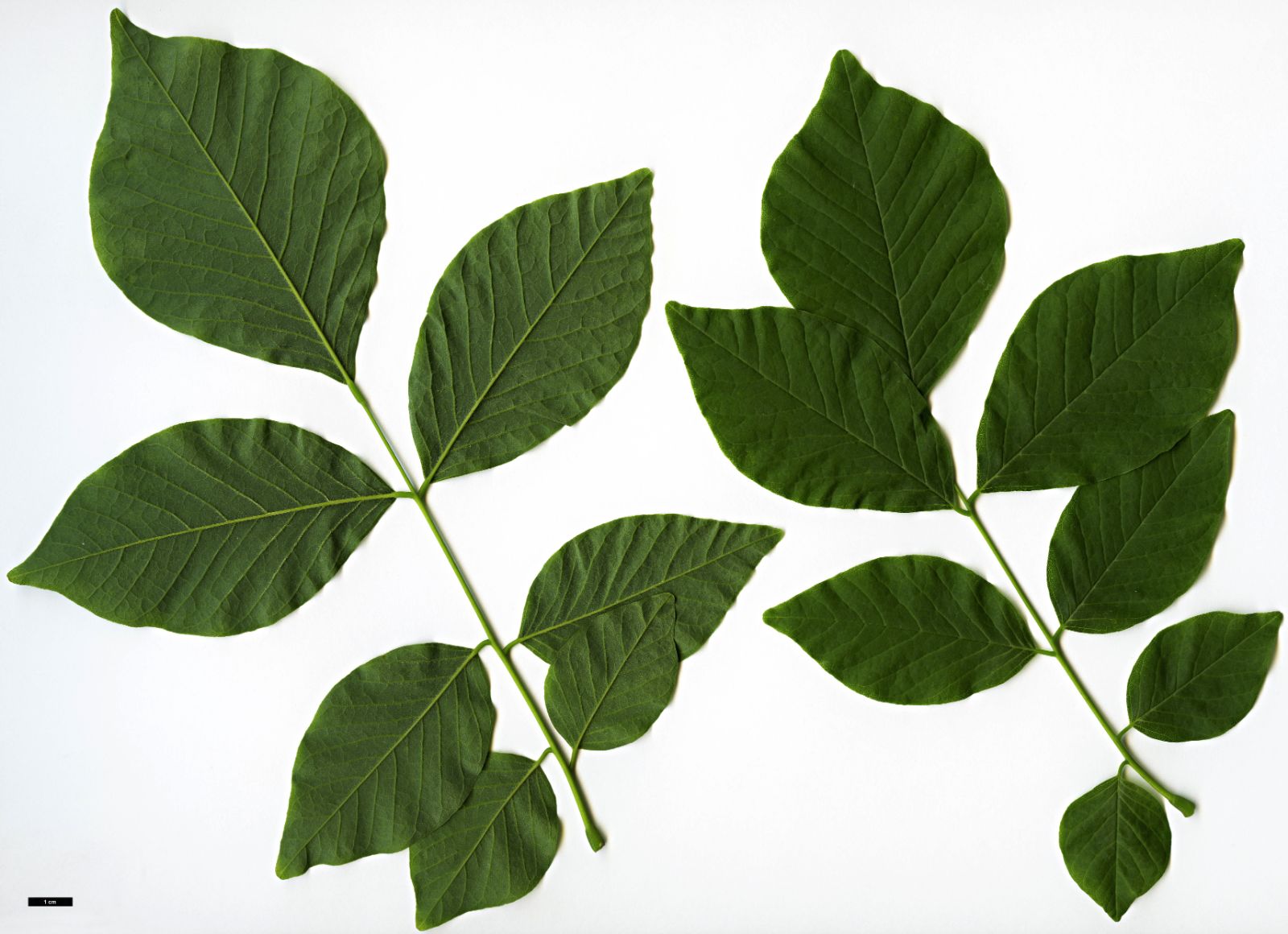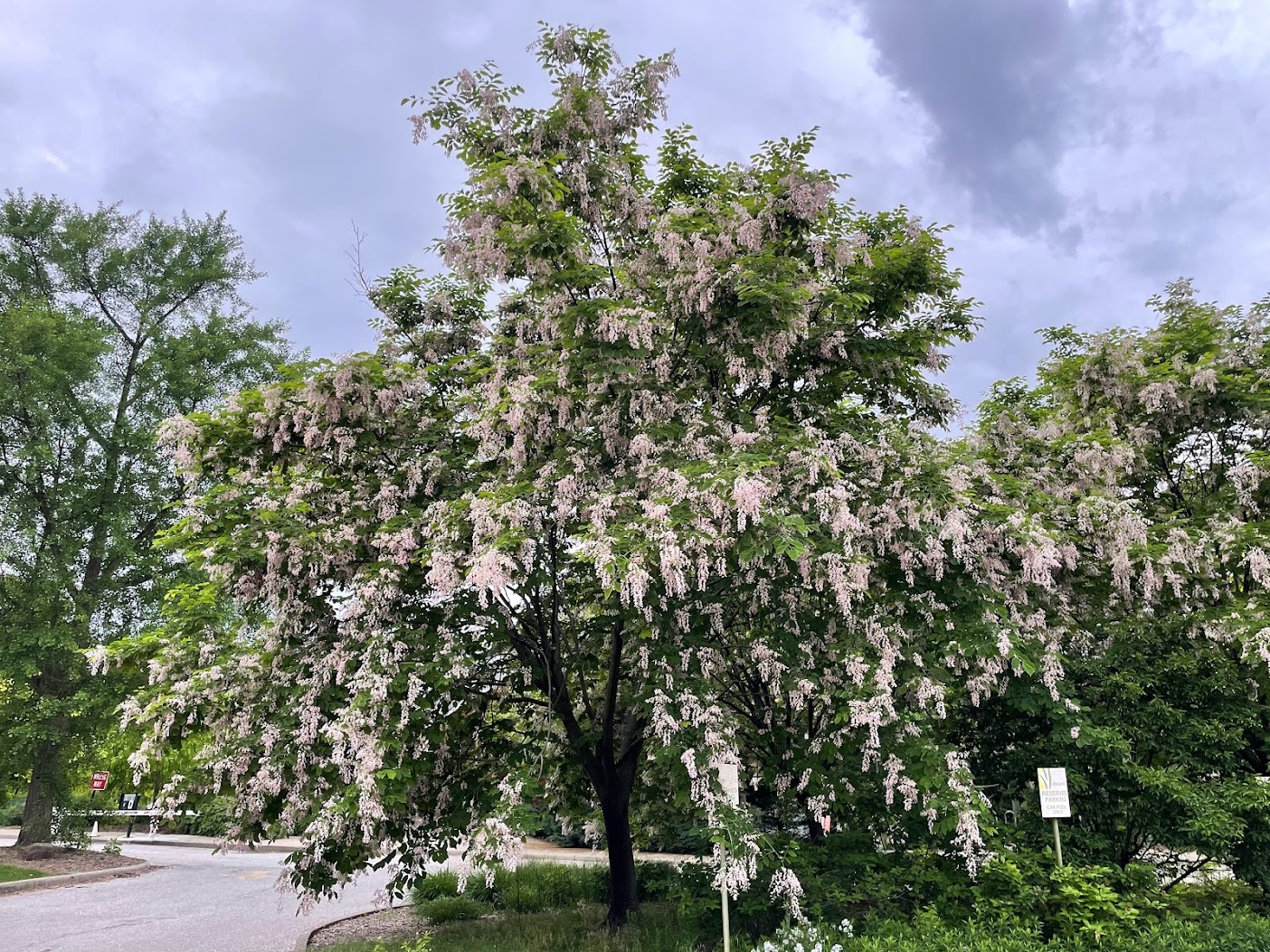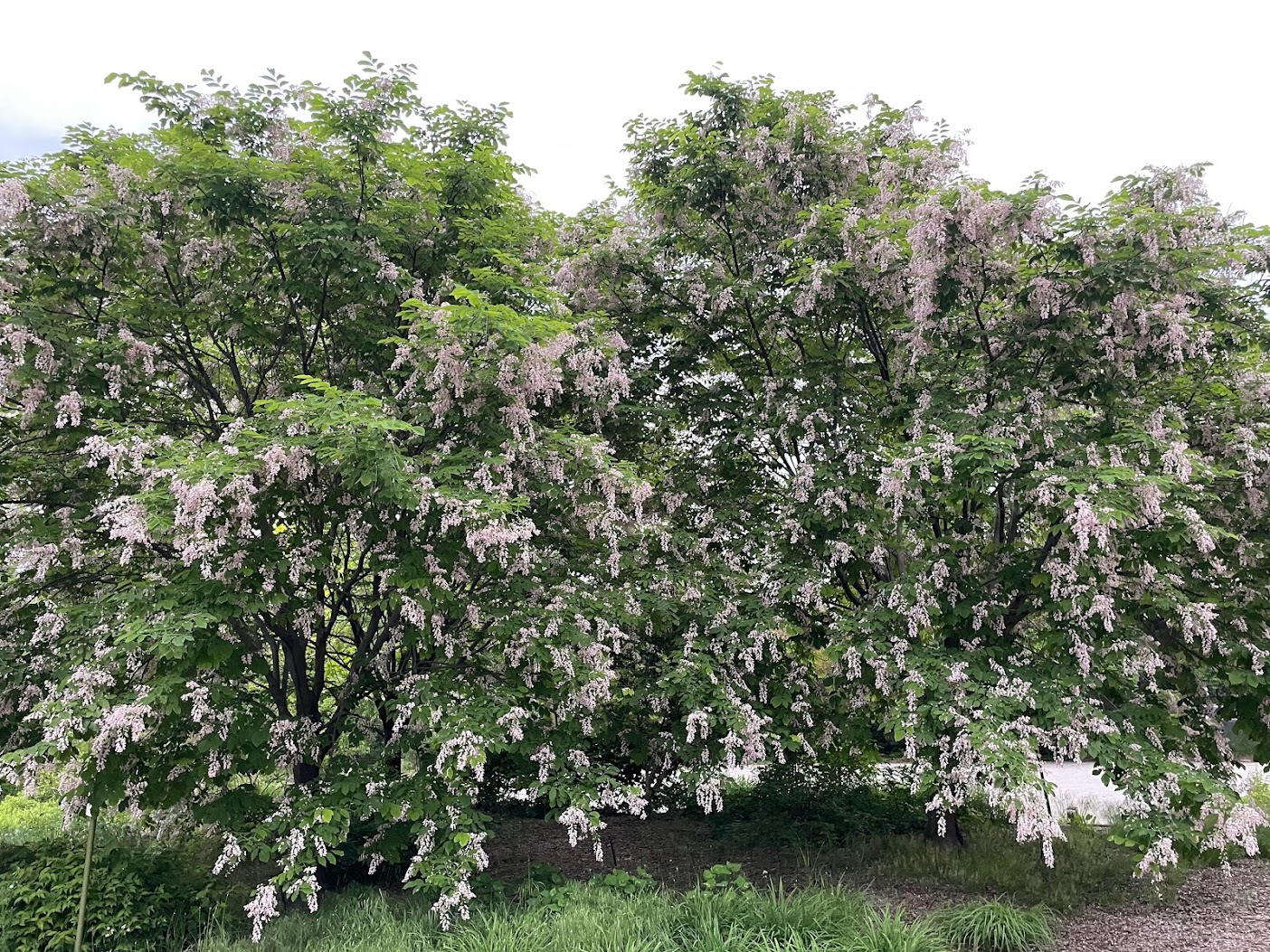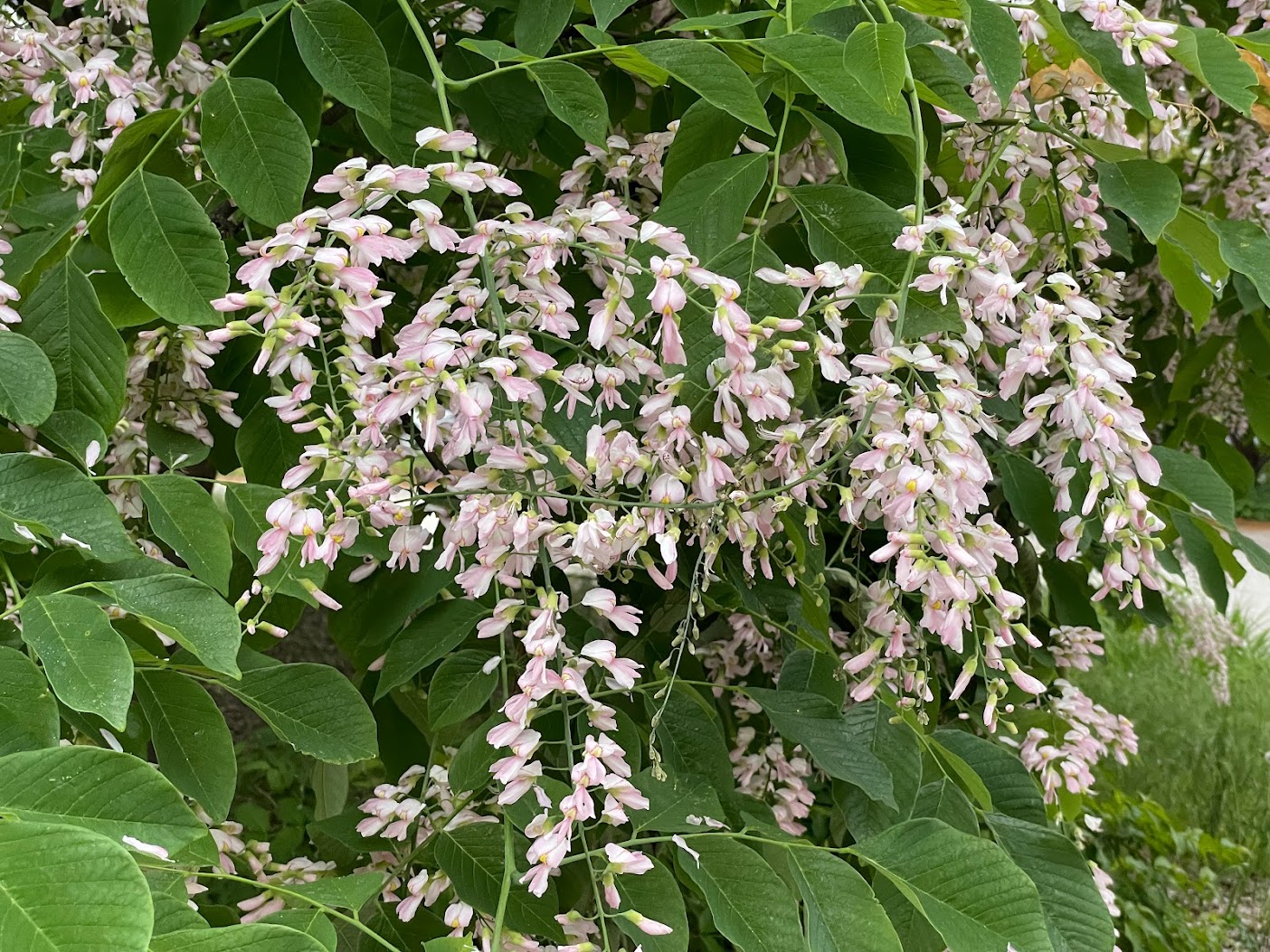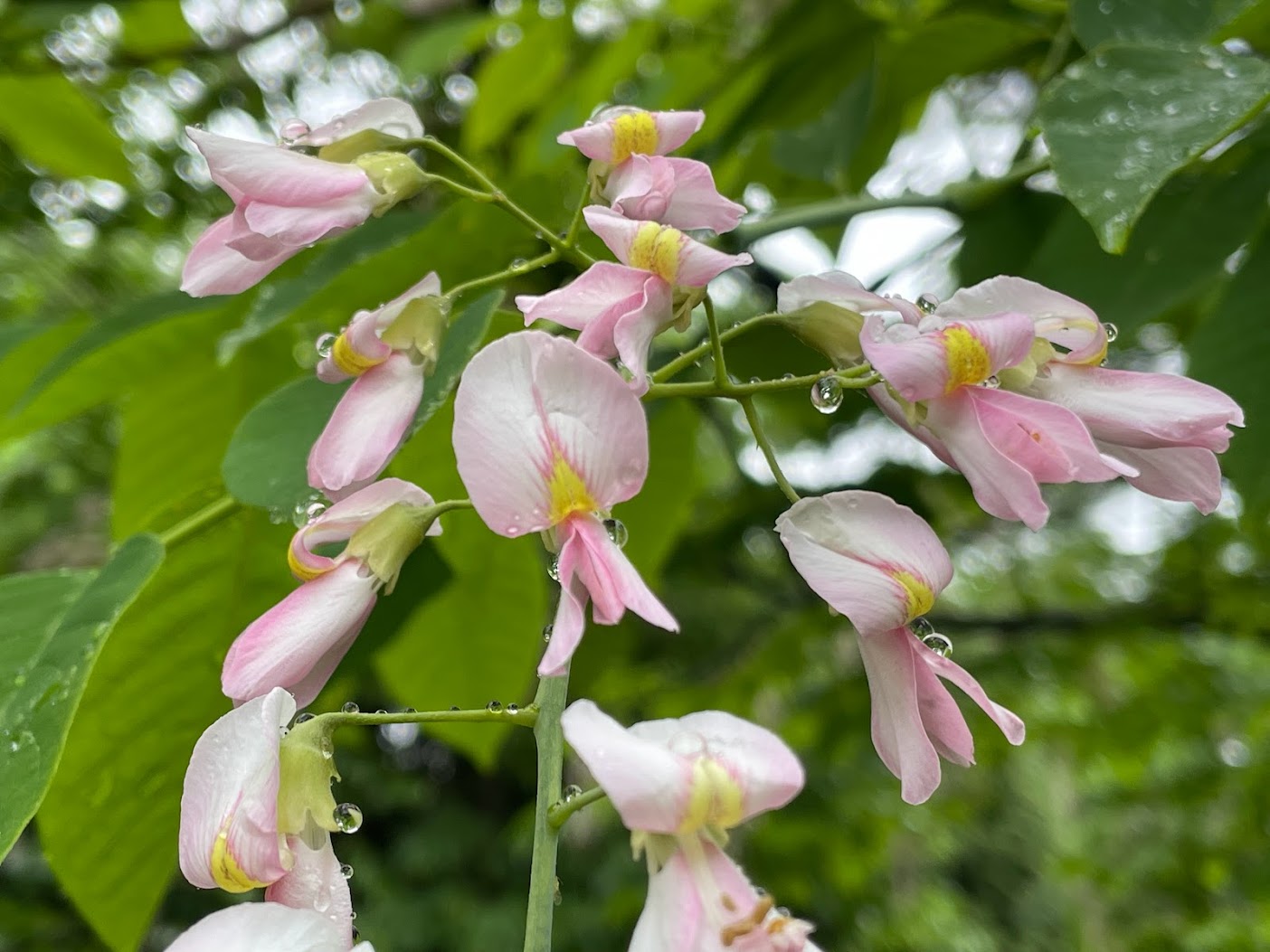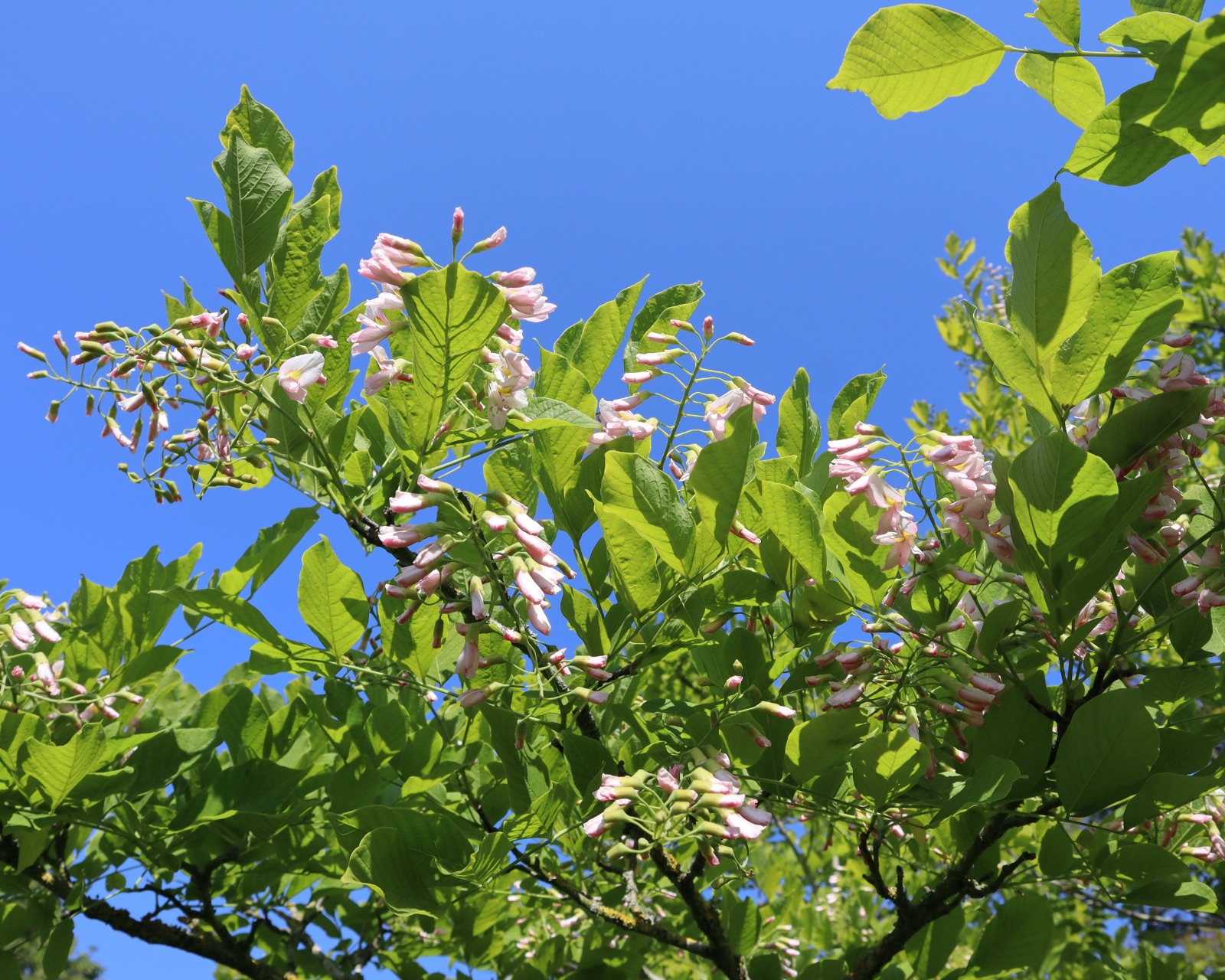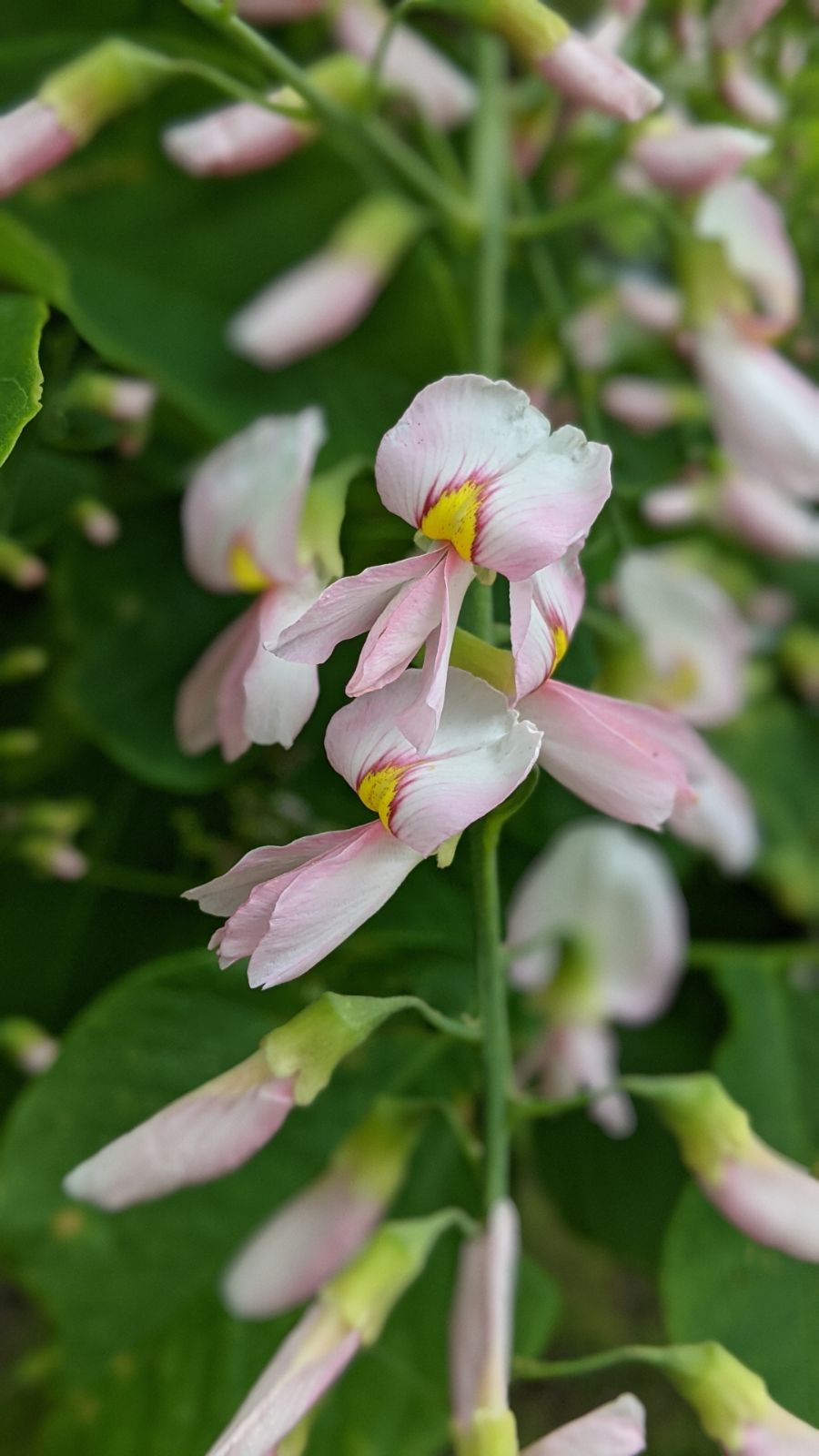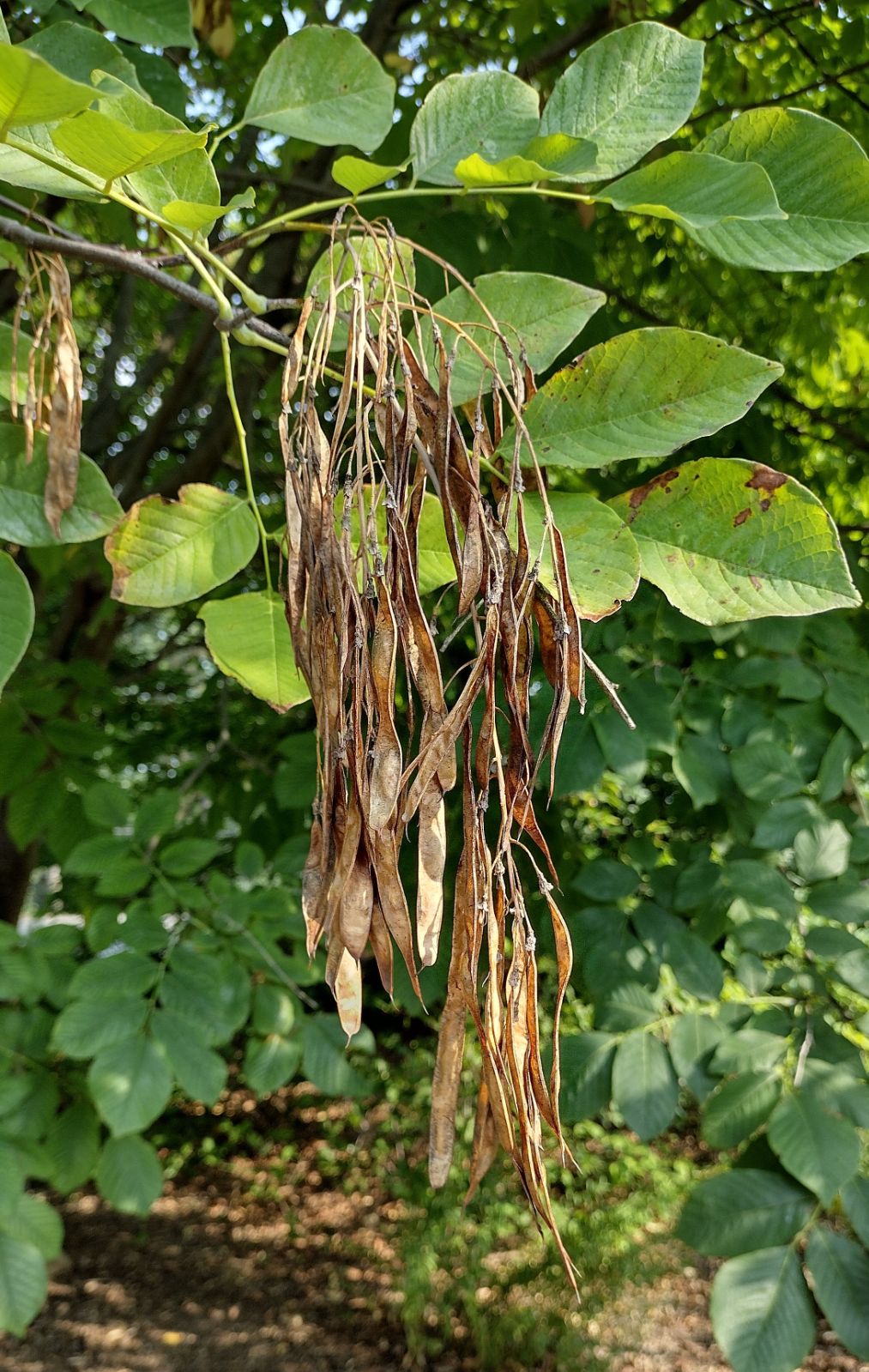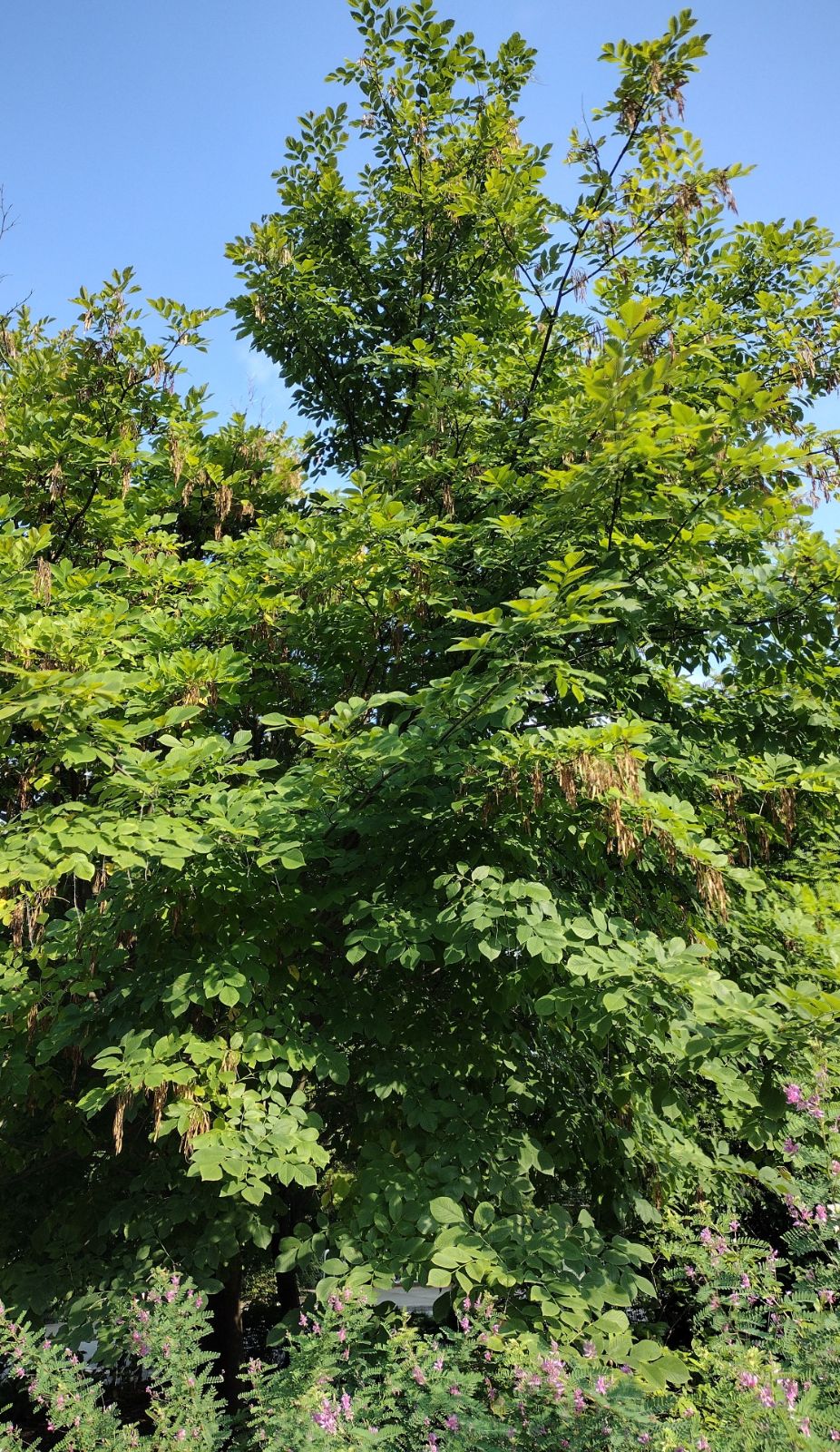Cladrastis kentukea
Credits
Owen Johnson (2021)
Recommended citation
Johnson, O. (2021), 'Cladrastis kentukea' from the website Trees and Shrubs Online (treesandshrubsonline.
Genus
Common Names
- American Yellow-wood
- Kentucky Yellow-wood
- Virgilia
- Gopherwood
Synonyms
- Cladrastis albiflora Raf.
- Cladrastis fragrans Raf.
- Cladrastis kentuckensis (Dum.Cours.) Jacks.
- Cladrastis lutea (Michx.) K. Koch
- Cladrastis tinctoria Raf.
- Sophora kentukea Dum.Cours.
- Virgilia lutea Michx.
Infraspecifics
Other taxa in genus
Tree 15–20 m tall (exceptionally to 27 m), usually branching widely from a short bole and often broader than tall. Bark thin, smooth, pale grey, with a pattern of small round lenticels. Shoot brown, slender, glabrous; buds short, concealed through summer within the hollow swollen base of the leaf-stalk. Leaves with (5–)7–11 untoothed leaflets alternately set on the rachis, each broadly ovate to obovate, 60–100 × 40–80 mm, with the terminal leaflet as large as 150 × 120 mm and rhomboid; bright green on both sides; usually hairless when mature. Inflorescence a terminal many-flowered drooping raceme or panicle 10–30(– 50) cm long, expanding with the leaves in late spring, the flowers opening after a few weeks; flowers white, rarely pink-tinged, with a pale yellow blotch at the base of the standard petal, sweetly vanilla-scented; calyx campanulate, 5-lobed, tube 5–7 mm long with blunt lobes to 2 mm long, covered like the flower-stalk by a minute down; petals to 20 mm long. Fruit a light-brown, flat, pendant pod, ripening in late summer and falling a little after the foliage in autumn, 60–100 × 8–12 mm, containing 4–6 brown seeds c. 7 × 4 mm (Bean 1976; Elias 1980; Cullen et al. 2011).
Distribution United States Alabama, Arkansas, Georgia, Illinois, Indiana, Kentucky, Louisiana, Mississippi, Missouri, North Carolina, Oklahoma, South Carolina, Tennessee
Habitat In woodlands along rivers and in nutrient-rich upland forests and calcareous bluffs, often located on or at the base of north-facing slopes; also occurring as an under-storey in tall, species-rich woodlands and nowhere very common.
USDA Hardiness Zone 4
RHS Hardiness Rating H7
Conservation status Least concern (LC)
Taxonomic note The American Yellow-wood was long known (and in some circles still is known) as Cladrastis lutea – a name published by K. Koch in 1869 based on Michaux’s description of ‘Virgilia lutea’ in 1813. Unknown to either of these botanists however, G.L.M. Dumont de Courset had already published a description in 1811 of a young, non-flowering plant in cultivation in France under the name Sophora kentukea. Velma Rudd was the first botanist to realise that Dumont de Courset’s name should have precedence, and published the name Cladrastis kentuckea in 1971 (correcting it to C. kentukea the following year) (Robertson 1977; Oregon State University 2020).
Cladrastis kentukea has a limited distribution with two main centres in the central southern United States. These are areas which escaped glaciation during the last Ice Age; the tree seems to have no current method of long-distance seed dispersal and seedlings are seldom found far from the parent tree. It is most frequent in moist forest glades in the Appalachian and Ozark highlands, and along the river cliffs and rocky ledges in central Kentucky and Tennessee (Hill 2007). Most of the wild populations are small and isolated, and have been further fragmented by the clearance of forests and by damming of the rivers along whose fertile banks the species liked to grow (Robertson 1977); lack of outbreeding is a potential genetic problem. The very broad leaflets which are a distinctive feature of the American Yellow-wood are an adaptation to low light-levels and in the wild the tree is often found under the canopy of taller species, and on cool north-facing slopes; it roots deeply (making it difficult to transplant) but is still prone to suffer in droughts, particularly if the sheltering canopy is clear-felled or when it is planted in hot, open situations (Hill 2007). The very thin bark offers no protection against forest fires (Hill 2007). A fungal pathogen, Botryosphaeria dothidea, is also a great hazard, particularly at the extremities of the natural range (Hill 2007). Although it is currently listed as a species of Least Concern by the IUCN, and within the United States is only listed as Endangered in Illinois (Hill 2007), Steven Hill’s excellent Conservation Assessment for Yellowwood in 2007 sounds a timely warming note: ‘the species itself is unlikely to be lost because of its value in cultivation, but, like the Franklin tree, ginkgo, and dawn redwood, it may be available to us only as cultivated individuals in the not so distant future’ (Hill 2007).
In its native habitats the tree grows rather slowly but can live to a great age. The timber yields a yellow dye; it is closely-grained and was favoured for gun-stocks, though seldom comes in good lengths (Hill 2007).
Cladrastis kentukea is a highly distinctive as well as a beautiful plant. Its leaves are larger than any of its east Asian relatives, with fewer but much broader leaflets (comparable in shape to those of the related Gymnocladus dioicus which grows in similar habitats but whose leaves are elaborately doubly-compound). The leaves flush rather late in spring and, in the lower light levels of northern Europe at least, they remain a beautiful fresh moss-green until autumn when they turn yellow, orange and even red. The flowers hang in bud as the leaves expand and open a couple of weeks later; trees generally take ten years from seed before they begin to flower and even then do not blossom every year but observe a cycle of two to five years (Robertson 1977). The flowers are sweetly vanilla-scented, especially in the evening, and attract bees and Black Swallowtail butterflies (Hill 2007). The hanging pea-like seed pods may persist for a little after leaf-fall – which K.R. Robertson in his monograph on the genus considered a demerit (Robertson 1977) – and then through winter the tree remains handsome and striking, with its wide spread and its cold grey bark which can wrinkle finely, as if bunched by muscles under the surface. Although as an ornamental the Yellow-wood takes up more room than most flowering trees, its deep roots mean that on a good soil other plants can successfully be grown underneath it (North Carolina Co-operative Extension 2021).
Its restricted distribution, away from the Atlantic seaboard, means that although C. kentukea is one of the most obviously garden-worthy of American trees, it was not among the first to be brought into cultivation by European settlers and explorers through the sixteenth and seventeenth centuries. André Michaux seems to have been the first botanist to notice the tree, in Tennessee in March 1796 (Robertson 1977); Dumont de Courset’s description based on a tree in France in 1811 indicates that Michaux was able to send seed across the Atlantic soon after this. J.C. Loudon stated that the Scottish plant-hunter John Lyon first introduced it to cultivation in Britain in 1812 (Andrews 1997).
Since then the Yellow-wood has been planted quite widely outside its natural range in North America. It is very hardy, although intense winter cold does seem to limit flowering and hence fertility; it has been observed to naturalise from planted trees as far north as Maine and in Ontario in southern Canada, though only in rich soils with a deep layer of leaf-litter (Hill 2007). It also thrives near the American west coast; Bob Van Pelt (Van Pelt 1996) has measured trees up to 22 m tall in Seattle, though summers here may not be warm enough for good seed production.
In the UK and Ireland C. kentukea will grow into a worthwhile though rather short-lived small tree, but will seldom receive enough summer heat to flower very well the following spring; autumn colour is more likely to be a pale yellow. The largest and most handsome trees are found in the warmest counties of southern and eastern England, although, rather remarkably, a tree as much as 20.5 m tall was reported in 2010 from the relatively cool National Botanic Garden at Glasnevin, Dublin (Tree Register 2021); this has since been lost. Another had reached 10 m in the Royal Botanic Garden Edinburgh in 1991, though in this chilly microclimate it proved particularly short-lived; even so, the species has been grown successfully in the shelter of the walled garden at Crathes Castle on Deeside, in the cold north-east of Scotland. Climate change is likely to make this tree a more enticing prospect across Britain; in the relatively cool summers of north Devon, John Marston’s planting at Gorwell House was growing into a beautiful tree in 2017 (Tree Register 2021). A specimen at Pampisford, Cambridgeshire, has grown well on shallow soils above pure chalk (T. Christian pers. comm. 2021). Although summers in its native habitat tend to be very warm, they are also humid, with rainfall totals only likely to be equalled in the far west of the UK and Ireland; a semi-mature tree 5 m tall had died back badly in the extreme early summer drought of 2018 in Chelsyn Gardens in Watford, Hertfordshire (Tree Register 2021), despite woodland shelter and a congenial soil.
Further south in Europe, the species performs more reliably. A very old tree, its hollow bole reduced to strips, is a feature of the Orto Botanico in Rome (monumentaltrees.com 2021). Online resources also indicate that it thrives and flowers beautifully in at least the south-east of Australia; one was added to the National Arboretum in Canberra in 2012 (Canberra National Arboretum 2021).
Plants from Alabama whose young leaves are particularly hairy underneath have been distinguished as f. tomentosa (Steyermark) Spongberg, but this variation is not considered significant (Robertson 1977).
A form with a weak, cream variegation has been reported by Michael Dirr (Dirr 2009) at Yew-Dell Gardens, Crestwood, Kentucky; this may be pathogenic rather than genetic.
'Perkins Pink'
Common Names
Pink-flowered Yellow-wood
Synonyms / alternative names
Cladrastis kentukea 'Rosea'
RHS Hardiness Rating: H7
USDA Hardiness Zone: 4
Wild trees of Cladrastis kentukea occasionally show a slight pinkish flush to their flowers, but a planted tree that grew in the mid twentieth century at Perkins School for the Blind in Watertown, Massachusetts, was unique in its clear pale pink blossoms, held horizontally or even erect (Robertson 1977; Spongberg & Ma 1997). Cuttings from this tree were cultivated at the Arnold Arboretum and distributed by Brimfield Nurseries in Connecticut from around 1963, originally under the name ‘Rosea’. The name ‘Perkins Pink’ was proposed by Spongberg and Ma in 1997 (Spongberg & Ma 1997), since the use of latinate cultivar names had by the 1960s been outlawed by the Cultivated Plant Code. (Chinese Yellow-wood, C. delavayi, whose flowers are more often pinkish, also has a selection originally distributed as ‘Rosea’.)
A plant of ‘Perkins Pink’ donated by the Arnold Arboretum was planted at the Royal Botanic Gardens, Kew, in 1988 (Andrews 1997), and the clone is now sold in the UK by Bluebell Nursery (Bluebell Arboretum and Nursery 2020).
'Sweetshade'
RHS Hardiness Rating: H7
USDA Hardiness Zone: 4
A plant selected for its vigorous, spreading habit and tendency to flower from an earlier age (Stewart 2021; Scott Arboretum 2021) – as quickly as two or three years from planting. Dirr (Dirr 2009) prefers ‘Sweet Shade’ for the form of the name, but seems unique in this.
'White Rain'
RHS Hardiness Rating: H7
USDA Hardiness Zone: 4
A sport with drooping branches, patented by Peter A. Driscoll in 2017. The habit is enhanced by the naturally hanging flower-heads, which this clone is said to produce within two to three years of planting (Jackson and Perkins 2021); autumn colour is described as yellow. It is unclear how well the pendulous habit will be expressed in mature trees.

